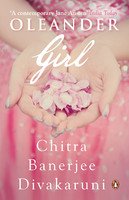
Review of Oleander Girl
Reviewed by Ananya Sarkar
A Compelling Novel
Chitra
Banerjee Divakaruni
Oleander Girl
Viking, Penguin, 2013
Pages 288
Price: Rs. 499

Chitra
Banerjee Divakaruni’s latest book Oleander Girl is the tale of seventeen-year
old Korobi Roy, who was orphaned at birth but nonetheless had a sheltered,
happy life with her maternal grandparents. The novel begins on the eve of her
engagement party to Rajat Bose, whose parents own an art gallery in Park
Street, Kolkata and another in New York. Notably, Korobi is also the only
granddaughter of Bimal Prasad Roy, a renowned former lawyer. Hence, the match
is perfect in terms of class and background. Also, Rajat and Korobi are very
much in love.
However, this picture-perfect scene is soon shattered when Bimal Roy suddenly
passes away on the evening of Korobi’s engagement. Consequently, Korobi
shockingly discovers that her father is alive and living in America. This
breaks the myth of her childhood. However, after overcoming her initial feeling
of anger and betrayal towards her grandparents (for having kept this truth from
her), Korobi decides to search for her father in order to fathom her roots and
come to terms with herself. The major portion of the novel deals with her
search while alternating it with the happenings at Kolkata at the same time.
The setting is in 2002. Often, there are
references to the Godhra riots. For example, on the morning of Korobi’s
engagement party, amid the bustle in the Roy household, the radio commentator
announces the news of the train fire in Gujarat. Later, when Bahadur and Asif
engage in friendly conversation, they both listen in consternation to the
transistor’s news of the continuing massacres in Gujarat. Though belonging to
different communities, they are careful not to hurt each other’s sentiments and
discuss the unrest objectively – “concluding that it was madness.” However, the
widespread impact of the riots is seen when communal conflict breaks out at the
Boses’ warehouse in Kolkata and spreads prejudice in the minds of many.
When Korobi goes to the U.S.A., we also get an
insight into the post 9/11 scenario. Seema tells Korobi about the drastic way
in which her husband, Mitra and her own life changed after the disaster. Many
South Asian businesses were boycotted, especially those with Muslim names, and
others were attacked. Included among these, was Mumtaz, the Boses’ art gallery
in New York, which was broken into. When Mitra, the manager and overseer of
Mumtaz went to the police to complain, not only were they unhelpful, but they
also detained him for two days for questioning. As his wife recounts, “Those
two days changed him, made him bitter and silent the way he’d never been.”
Seema too developed a fear for strangers. Even Vic recalls how his restaurant
business started suffering heavy losses after 9/11. As he says, “We aren’t used
to shit like this happening inside our own borders, America the protected. We
needed to find an enemy to lash out. Some people did, and folks like Mitra
became the casualties.”
However, here, the repercussion of the 9/11
tragedy is depicted at a distance, unlike the first-hand experiences of Rakhi
in Queen of Dreams and Uma in One Amazing Thing. The Godhra riots and the Twin
Towers crash have a parallel in each other as they are both the culmination of
communal intolerance. However, through Asif, Divakaruni makes us realise that
there were certain bonds stronger than religion, and these have the power to
shape a brighter future.
The characters in the book are appealing. The
central character, Korobi evolves in the course of the novel and matures as a
woman of substance. The others, like Mrs. Bose, the sophisticated wife of the
rich entrepreneur, and Sarojini, the traditional matron, break the types into
which they seem to fall at first glance. Notably, the character of Asif, the
Boses’ car driver, is endearing in its poignancy.
The title of the novel is aptly justified as
Korobi, the “oleander girl”, loves the oleanders that grow in the Roys’ garden.
Time and again, Korobi’s fondness and association with the oleander is hinted
at. For example, even after practicing her lie to have a swanky house made for
her, Korobi ends up telling an architect how she would like a house with
oleanders. Later, Korobi’s father tells her that her mother loved oleanders as
well, and as a memory of her, he had rows of oleanders in his garden. When
Korobi asks him about whether he knew why her mother named her so, he replies
that it was because the korobi flower or oleander was beautiful “but also
tough.” As the oleander could protect itself from predators, Korobi’s mother
wanted the same stamina and resilience in her daughter. And indeed, Korobi’s
journey of selfhood depicts her to be very much like the oleander.
The book review of Oleander Girl by Chitra Banerjee Divakaruni is continued here.....






